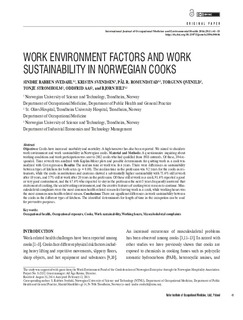| dc.contributor.author | Svedahl, Sindre Rabben | |
| dc.contributor.author | Svendsen, Kristin V Hirsch | |
| dc.contributor.author | Romundstad, Pål Richard | |
| dc.contributor.author | Qvenild, Torgunn | |
| dc.contributor.author | Strømholm, Tonje | |
| dc.contributor.author | Aas, Oddfrid | |
| dc.contributor.author | Hilt, Bjørn | |
| dc.date.accessioned | 2018-02-23T12:11:01Z | |
| dc.date.available | 2018-02-23T12:11:01Z | |
| dc.date.created | 2015-11-26T08:52:45Z | |
| dc.date.issued | 2016 | |
| dc.identifier.citation | International Journal of Occupational Medicine and Environmental Health. 2016, 29 (1), 41-53. | nb_NO |
| dc.identifier.issn | 1232-1087 | |
| dc.identifier.uri | http://hdl.handle.net/11250/2486739 | |
| dc.description.abstract | Objectives: Cooks have increased morbidity and mortality. A high turnover has also been reported. We aimed to elucidate work environment and work sustainability in Norwegian cooks. Material and Methods: A questionnaire inquiring about working conditions and work participation was sent to 2082 cooks who had qualified from 1988 onwards. Of these, 894 responded. Time at work was analyzed with Kaplan-Meier plots and possible determinants for quitting work as a cook was analyzed with Cox regression. Results: The median time at work was 16.6 years. There were differences in sustainability between types of kitchens for both sexes (p = 0.00). The median time in the profession was 9.2 years for the cooks in restaurants, while the cooks in institutions and canteens showed a substantially higher sustainability with 75.4% still at work after 10 years, and 57% still at work after 20 years in the profession. Of those still at work as a cook, 91.4% reported a good or very good contentment, and the 67.4% who expected to stay in the profession the next 5 years frequently answered that excitement of cooking, the social working environment, and the creative features of cooking were reasons to continue. Musculoskeletal complaints were the most common health-related reason for leaving work as a cook, while working hours was the most common non-health-related reason. Conclusions: There are significant differences in work sustainability between the cooks in the different types of kitchens. The identified determinants for length of time in the occupation can be used for preventive purposes. | nb_NO |
| dc.language.iso | eng | nb_NO |
| dc.publisher | Instytut Medycyny Pracy im. prof J. Nofera (Nofer Institute of Occupational Medicine) | nb_NO |
| dc.rights | Navngivelse-Ikkekommersiell 4.0 Internasjonal | * |
| dc.rights.uri | http://creativecommons.org/licenses/by-nc/4.0/deed.no | * |
| dc.title | Work environment factors and work sustainability in Norwegian cooks | nb_NO |
| dc.type | Journal article | nb_NO |
| dc.type | Peer reviewed | nb_NO |
| dc.description.version | publishedVersion | nb_NO |
| dc.source.pagenumber | 41-53 | nb_NO |
| dc.source.volume | 29 | nb_NO |
| dc.source.journal | International Journal of Occupational Medicine and Environmental Health | nb_NO |
| dc.source.issue | 1 | nb_NO |
| dc.identifier.doi | 10.13075/ijomeh.1896.00446 | |
| dc.identifier.cristin | 1293459 | |
| dc.relation.project | Næringslivets Hovedorganisasjon: S-2832 | nb_NO |
| dc.description.localcode | This work is available in Open Access model and licensed under a Creative Commons Attribution-NonCommercial 3.0 Poland License – http://creativecommons.org/ licenses/by-nc/3.0/pl/deed.en. | nb_NO |
| cristin.unitcode | 194,65,20,0 | |
| cristin.unitcode | 194,60,25,0 | |
| cristin.unitname | Institutt for samfunnsmedisin og sykepleie | |
| cristin.unitname | Institutt for industriell økonomi og teknologiledelse | |
| cristin.ispublished | true | |
| cristin.fulltext | original | |
| cristin.qualitycode | 1 | |

